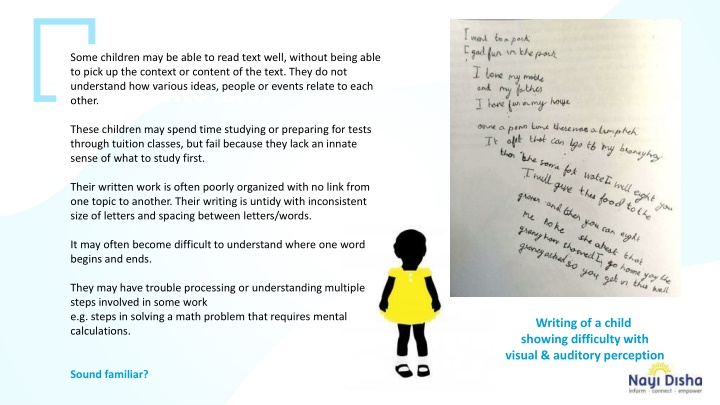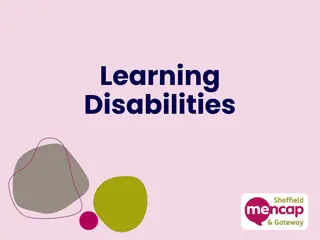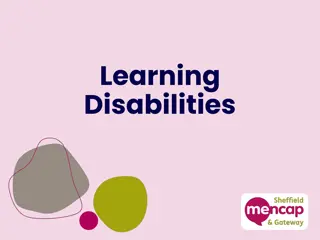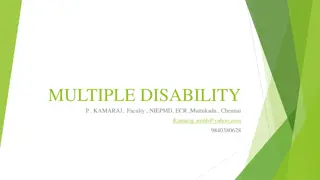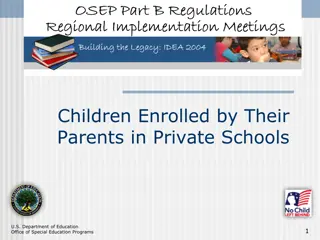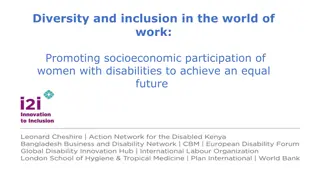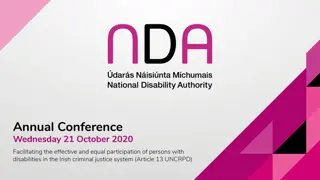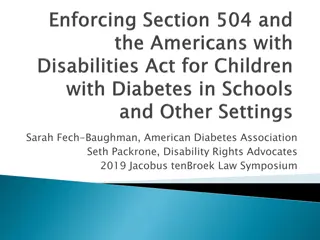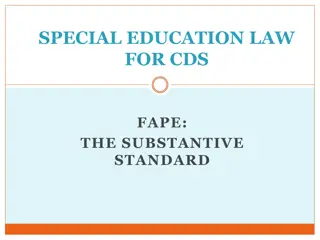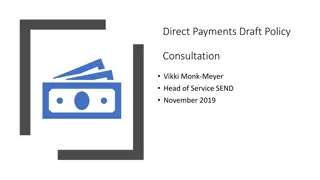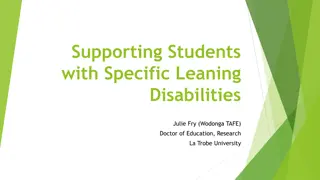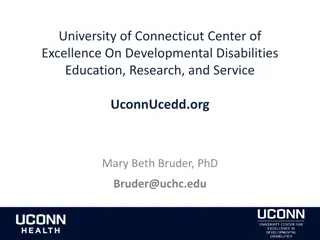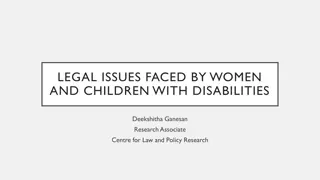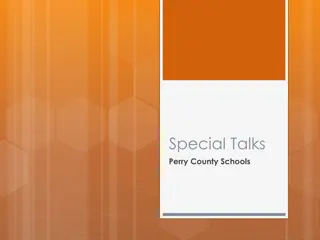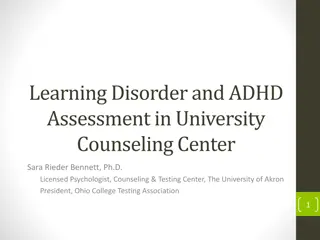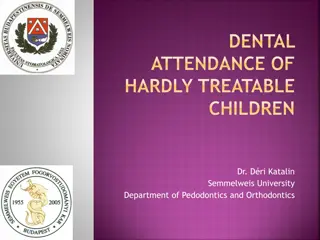Specific Learning Disabilities (SLD) in Children
Children with Specific Learning Disabilities (SLD) may struggle with reading comprehension, organization, and processing information. This can lead to academic difficulties and emotional challenges. Factors such as prenatal complications and genetic influences can contribute to SLD. Recognizing the signs and providing support can help these children lead happy and fulfilling lives despite their learning constraints.
Uploaded on Feb 19, 2025 | 2 Views
Download Presentation

Please find below an Image/Link to download the presentation.
The content on the website is provided AS IS for your information and personal use only. It may not be sold, licensed, or shared on other websites without obtaining consent from the author.If you encounter any issues during the download, it is possible that the publisher has removed the file from their server.
You are allowed to download the files provided on this website for personal or commercial use, subject to the condition that they are used lawfully. All files are the property of their respective owners.
The content on the website is provided AS IS for your information and personal use only. It may not be sold, licensed, or shared on other websites without obtaining consent from the author.
E N D
Presentation Transcript
SPECIFIC LEARNING DISABILITIES (SLD) other. Some children may be able to read text well, without being able to pick up the context or content of the text. They do not understand how various ideas, people or events relate to each These children may spend time studying or preparing for tests through tuition classes, but fail because they lack an innate sense of what to study first. Their written work is often poorly organized with no link from one topic to another. Their writing is untidy with inconsistent size of letters and spacing between letters/words. v It may often become difficult to understand where one word begins and ends. They may have trouble processing or understanding multiple steps involved in some work e.g. steps in solving a math problem that requires mental calculations. Writing of a child showing difficulty with visual & auditory perception Sound familiar?
THE REALITY Children with a learning disability speak well & are smart & intelligent. However, they have academic difficulties which in turn cause emotional & behavioral problems. LET S TALK ABOUT SPECIFIC LEARNING DISABILITIES (SLDS) OBSERVATION This leaves parents & teachers confused. The child s behavior is misinterpreted as lack of motivation or interest. v THE EFFECT ON THE CHILD The child is left feeling misunderstood & frustrated. UNDERSTANDING THE PROBLEM These children have trouble in Processing information from visual & sensory perception Organization of information to process the ability to read, write or do mathematics.
A child with an SLD is one who Is intelligent but fails in school 01 Writes on for no , was for saw , or 14 for 41 02 Hears the dog bark at a distance but does not hear what the teachers are saying 03 Remembers sequence of shows on TV but not mathematical tables 04 Is confused with sense of time relative to one another, such as what is today, yesterday or tomorrow 05 Is disorganized, messy, moody & poor about time management 06 Is enthusiastic to finish a task, but one that never comes out the way intended. 07 Omits, adds, skips words while reading 08 Can do mathematical calculations but cannot express it in paper 09 Has very low attention span on a given task 10
PRENATAL FACTORS Can be due to pregnancy complications such as toxemia, bleeding, pre-maturity, low birth weight, anoxia or drug abuse are some factors that may influence the brain leading to a learning disability. THERE IS NO SPECIFIC CAUSE FOR LEARNING DISABILITY. ENSURING A SAFE, HEALTHY PREGNANCY AND POST NATAL CARE IS THE MOST YOU CAN DO PROTECT YOUR CHILD. A LOT CAN BE DONE TO HELP THE CHILD LEAD A HAPPY LIFE WITH HIS/HER LEARNING CONSTRAINTS. POST NATAL FACTORS Children born with post-birth trauma, head injury, lead poisoning, seizures, encephalitis or meningitis are some factors that may influence the brain leading to a learning disability. Causes of SLD GENETIC FACTORS While genes remain unknown, it is not uncommon for a parent to report that they or a close family member had learning difficulties.
TYPES OF SLD DYSPRAXIA DYSGRAPHIA DYSCALCULIA DYSLEXIA DIFFICULTY IN MOTOR PLANNING DIFFICULTY IN WRITING (handwriting & expressive writing) DIFFICULTY IN MATH DIFFICULTY READING
A CHILDSINTELLECTUALDEVELOPMENT The first 6 years of a child s life are very important 6 YRS Window of development during which thinking skills progress 2 YRS 4 YRS 3 YRS 5 YRS 1 YR Many factors influence the way the brain develops & we have little control over some. However, we can identify children who are likely to be at risk .
A child at risk for SLD is one who Below 5 years of age Delayed acquisition of motor skills, language difficulties, perceptual problems & poor social skills are early marker suggestive of potential problems in learning. Does not know their own age 01 Is ambidextrous uses both left and right hands 02 Has difficulty in doing up buttons 03 Reverses letters & numbers when copying or writing 04 Slow & fumbling in putting on shoes or clothes. 05 Trips over, bumps into or knocks over objects 06 Cannot keep within lines when coloring 07 Lacks sense of rhythm keeping in time with music, when running or clapping? 08 Has difficulty pronouncing specific sounds, e.g. Wed for Red, Fink for Think, Muver for Mother 09
A child at risk for SLD is one who Below 5 years of age Delayed acquisition of motor skills, language difficulties, perceptual problems & poor social skills are early marker suggestive of potential problems in learning. Uses baby talk Me for I, Runned for Ran, Dood for Did 10 Lacks verbal fluency. Speaks in words or phrases 11 Mixes up order of words in a sentence 12 Loses main thread and goes into irrelevant details when telling a story or talking 13 Has difficulty remembering poems, rhymes. 14 Cannot count upto 20 15 Confuses names of colors 16 Daydreams 17 Slow in carrying out commands 18
A child at risk for SLD is one who Below 5 years of age Delayed acquisition of motor skills, language difficulties, perceptual problems & poor social skills are early marker suggestive of potential problems in learning. Overactive on the move 19 Has difficulty sitting still for a long time 20 Fidgets with things 21 Lacks concentration and does not pay attention 22 Frequently loses belonging 23 NOT EVERY CHILD WITH SLD WILL HAVE ALL THE CHARACTERISTICS. HOWEVER, EACH WILL HAVE A CLUSTER OF THEM The three Rs are basic skills taught in schools: reading, writing and arithmetic. Teaching 3R s to young children who are not ready biologically is not only counter-productive, but also harmful emotionally as it lowers one s self esteem.
A child at risk for SLD is one who Above 5 years of age Delayed acquisition of motor skills, language difficulties, perceptual problems & poor social skills are early marker suggestive of potential problems in learning. Learning & remembering rhymes or recognizing rhyming words (e.g. sell, bell, well) 01 Difficulty in hearing sounds such as b,p,d,g,j,u,y,l,f,v.h 02 Lack of interest in listening to stories & failure to understand when explanation is given 03 Poor motor control difficulty when using scissors, holding a pencil & coloring between the lines 04 Trouble in deciding which hand to use for what? 05 Sequencing & matching games maybe difficult 06 Putting on clothes, buttoning, typing shoe laces may be difficult 07 Copying from the board is difficult. Lines are missing or letters & numbers get transposed. 08 May reverse letters, words & numbers while writing 09
A child at risk for SLD is one who Above 5 years of age Delayed acquisition of motor skills, language difficulties, perceptual problems & poor social skills are early marker suggestive of potential problems in learning. Does not know the days of the week, months of the year in sequence 10 Is confused by a page crowded with print & illustrations 11 Does well in one subject but poorly in others 12 Is upset by changes in routine 13 Has history of delayed speech or language development 14 Has difficulty with sequencing in calculations with numbers 15 Difficulties in learning tables by rote 16 Is slow in finishing written work 17 Low tolerance or frustration 18
A child at risk for SLD is one who Above 5 years of age Delayed acquisition of motor skills, language difficulties, perceptual problems & poor social skills are early marker suggestive of potential problems in learning. Appears reckless & uninhibited/impulsive 19 Can understand concrete ideas better than abstract ideas 20 Oral reading is inaccurate. Reads word by word. Pays no attention to punctuation 21 NOT EVERY CHILD WITH SLD WILL HAVE ALL THE CHARACTERISTICS. HOWEVER, EACH WILL HAVE A CLUSTER OF THEM The three Rs are basic skills taught in schools: reading, writing and arithmetic. Teaching 3R s to young children who are not ready biologically is not only counter-productive, but also harmful emotionally as it lowers one s self esteem.
This content has been developed in collaboration with Remedial & Special Educator Ms.Farida Raj. It has been adapted from her book ''Breaking Through" - A Hand Book for Teachers and Parents of Children with Learning Difficulties & reproduced here with consent. NAYI DISHA RESOURCE CENTRE Join Us on Facebook Nayi Disha Resource Centre is an online information resource platform that supports families of persons with, Specific Learning Disabilities, Intellectual & Developmental Disabilities. Join Us on Twitter Join Us on Linkedin Visit us at WWW.NAYI-DISHA.ORG
